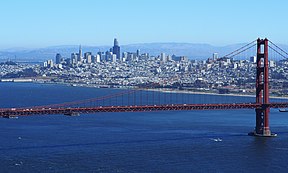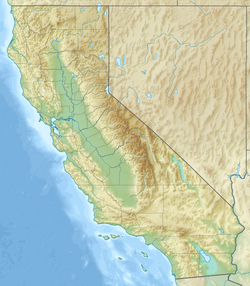San Francisco
San Francisco is a city in the state of California in the United States. It is in the northern part of California, between the Pacific Ocean and San Francisco Bay. With 873,965 people in 2020, San Francisco is the 4th largest city in California and the 17th largest city in the United States. It is the economic and cultural center of the San Francisco Bay Area, a metropolitan area with over 7 million people. The city is famous for the Golden Gate Bridge, steep hills, unique architecture, and its large LGBTQ+ population.
San Francisco | |
|---|---|
| City and County of San Francisco | |
Golden Gate Bridge and San Francisco skyline as seen from the Marin Headlands | |
|
| |
| Nicknames: | |
| Motto(s): | |
| Anthem: Official song: Theme from San Francisco ("open your Golden Gate") Official ballad:"I Left My Heart in San Francisco"[2][3] | |
 Interactive map outlining San Francisco | |
| Coordinates: 37°46′39″N 122°24′59″W / 37.77750°N 122.41639°W | |
| Country | United States |
| State | California |
| County | San Francisco |
| Metro | San Francisco–Oakland–Hayward |
| CSA | San Jose–San Francisco–Oakland |
| Mission | June 29, 1776[4] |
| Incorporated | December 16, 1848[5] |
| Founded by | Juan Bautista de Anza José Joaquín Moraga Francisco Palóu |
| Named for | St. Francis of Assisi |
| Government | |
| • Type | Strong mayor–council |
| • Body | Board of Supervisors |
| • Mayor | London Breed (D)[6] |
| • Supervisors[10] | List
|
| • Assembly members[11][12] | Matt Haney (D) Phil Ting (D) |
| • State senator | Scott Wiener (D)[7] |
| • United States Representatives | Nancy Pelosi (D)[8] Kevin Mullin (D)[9] |
| Area | |
| • City and county | 231.89 sq mi (600.59 km2) |
| • Land | 46.9 sq mi (121.48 km2) |
| • Water | 184.99 sq mi (479.11 km2) 80.00% |
| • Metro | 3,524.4 sq mi (9,128 km2) |
| Elevation | 52 ft (16 m) |
| Highest elevation | 934 ft (285 m) |
| Lowest elevation [15] (Pacific Ocean) | 0 ft (0 m) |
| Population | |
| • City and county | 873,965 |
| • Estimate (2022)[16] | 808,437 |
| • Rank | 39th in North America 17th in the United States 4th in California |
| • Density | 18,634.65/sq mi (7,194.88/km2) |
| • Urban | 3,515,933 (US: 14th) |
| • Urban density | 6,843.0/sq mi (2,642.1/km2) |
| • Metro | 4,566,961 (US: 13th) |
| • CSA | 9,225,160 (US: 5th) |
| Demonym | San Franciscan[20] |
| GDP | |
| • City and county | $252.2 billion (2022) |
| • Metro | $729.1 billion (2022) |
| • CSA | $1.318 trillion (2022) |
| Time zone | UTC–08:00 (PST) |
| • Summer (DST) | UTC–07:00 (PDT) |
| ZIP Codes[22] | List
|
| Area codes | 415/628[23] |
| FIPS code | 06-67000 |
| GNIS feature IDs | 277593, 2411786 |
| Website | sf.gov |
| |
Spanish explorers created San Francisco in 1776. They called it "Yerba Buena", which is Spanish for "Good Herb", because a lot of mint grew there.[24] After the Mexican-American War, the United States took over Yerba Buena. In 1848 its name was changed to "San Francisco". It became a city in 1850. San Francisco was a center of the Beat Generation in the 1950s and the Hippie movement in the 1960s. Today, it is a center of social and political liberalism.
When the California Gold Rush started in 1848, San Francisco's port became very important. Immigrants came by sea from around the world. During World War II, the city was a center of war industries.[25] In the 1990s, the economy became focused on internet companies and other high tech. Many of the world's largest companies have their main offices in San Francisco, such as Wells Fargo, Salesforce, Uber, Airbnb, Twitter, Levi's, Gap, Dropbox, and Lyft.[26][27] The city has among the highest average incomes and highest housing costs in the United States.
Geography
changeSan Francisco is at the north end of the San Francisco Peninsula. The Pacific Ocean is to its west, and the San Francisco Bay is to its east. The Golden Gate, a strait that connects the ocean and the bay, is to its north. The cities of Daly City and Brisbane, in San Mateo County, are to its south. It has a total land area of 46.9 square miles, or 121 square kilometers.
Several islands are part of the city: Alcatraz, Treasure Island, and Yerba Buena Island in the bay, and the Farallon Islands in the ocean. The Farallon Islands are a protected nature reserve. Only scientists can visit them.
Climate
changeSan Francisco has a warm-summer Mediterranean climate (Csb in the Köppen climate classification). The record high temperature is 41.1 °C (106 °F) on September 1, 2017. The record low temperature is -4.4 °C (24 °F) on December 9, 1972.
| Climate data for San Francisco (1981-2010, Sun 1961-1974, Extremes 1874-) | |||||||||||||
|---|---|---|---|---|---|---|---|---|---|---|---|---|---|
| Month | Jan | Feb | Mar | Apr | May | Jun | Jul | Aug | Sep | Oct | Nov | Dec | Year |
| Record high °C (°F) | 26.1 (79.0) |
27.2 (81.0) |
29.4 (84.9) |
34.4 (93.9) |
38.3 (100.9) |
39.4 (102.9) |
39.4 (102.9) |
36.7 (98.1) |
41.1 (106.0) |
38.9 (102.0) |
30.0 (86.0) |
24.4 (75.9) |
41.1 (106.0) |
| Average high °C (°F) | 13.8 (56.8) |
15.7 (60.3) |
16.6 (61.9) |
17.3 (63.1) |
17.9 (64.2) |
19.1 (66.4) |
19.2 (66.6) |
20.1 (68.2) |
21.2 (70.2) |
20.7 (69.3) |
17.3 (63.1) |
13.9 (57.0) |
17.7 (63.9) |
| Average low °C (°F) | 7.6 (45.7) |
8.6 (47.5) |
9.2 (48.6) |
9.6 (49.3) |
10.6 (51.1) |
11.6 (52.9) |
12.3 (54.1) |
12.8 (55.0) |
12.8 (55.0) |
12.1 (53.8) |
10.1 (50.2) |
7.8 (46.0) |
10.4 (50.8) |
| Record low °C (°F) | −3.3 (26.1) |
−1.1 (30.0) |
−0.5 (31.1) |
2.2 (36.0) |
3.9 (39.0) |
— | 6.7 (44.1) |
5.6 (42.1) |
5.0 (41.0) |
2.8 (37.0) |
−0.5 (31.1) |
−4.4 (24.1) |
−4.4 (24.1) |
| Average rainfall mm (inches) | 114.3 (4.50) |
113.3 (4.46) |
82.8 (3.26) |
37.1 (1.46) |
17.8 (0.70) |
4.1 (0.16) |
0.0 (0.0) |
1.5 (0.06) |
5.3 (0.21) |
28.4 (1.12) |
80.3 (3.16) |
115.8 (4.56) |
600.7 (23.65) |
| Average rainy days | 11.7 | 11.1 | 11.0 | 6.5 | 3.8 | 1.5 | 0.3 | 1.0 | 1.7 | 3.9 | 8.9 | 11.6 | 73.0 |
| Mean monthly sunshine hours | 185.9 | 207.7 | 269.1 | 309.3 | 325.1 | 311.4 | 313.3 | 287.4 | 271.4 | 247.1 | 173.4 | 160.6 | 3,061.7 |
| Source 1: NOAA[28][29] | |||||||||||||
| Source 2: Intellicast[30] | |||||||||||||
Demographics
change2020 census
changeIn the 2020 census, there were 873,965 people, 371,851 households, and 172,912 families living in San Francisco. The population density was 18,629.1 people per square mile (7,192.7/km²). There were 406,628 housing units. The breakdown by race was 41.3% White, 33.9% Asian, 5.3% Black, 0.7% Native American, 0.4% Pacific Islander, 8.4% from one other race, and 9.9% from two or more races. Hispanics and Latinos made up 15.6% of the people.
The median (middle) age was 38.2 years. The age breakdown was 13.0% under age 18, 70.8% from 18 to 65, and 16.3% over 65. The gender breakdown was 51.0% male and 49.0% female.
Of the households, 18.6% had children under age 18, 33.8% had a married couple, 9.1% had an unmarried couple, 29.7% had a woman with no partner, 27.3% had a man with no partner, and 36.2% had one person living alone. The average household size was 2.28 people.[31][32]
Government and politics
changeSan Francisco is officially called the City and County of San Francisco. It is the only city in California that is also a county. It is a charter city, which means it can choose its own system of government.
San Francisco has a mayor and a board of supervisors. The city is divided into 11 districts. Each district elects one supervisor to the board. Half of them are elected every two years. They serve as supervisor for four years after the election. The mayor is elected every four years. Elections for mayor and supervisors use instant-runoff voting.[33]
Since 1960, San Francisco has voted for the Democratic candidate in every presidential election. Since 2004, the Democratic candidate has won more than 80% of the votes in each election. Every mayor since 1964 has been a Democrat.
Transport
changePublic transport
changeThe city of San Francisco has a public transport system called San Francisco Municipal Railway, or Muni for short. It operates light rail trains, called Muni Metro; buses; streetcars; and cable cars. The cable cars are the oldest and the most famous.
Bay Area Rapid Transit, or BART, operates one rapid transit train line through San Francisco. It carries people south to San Mateo County and to San Francisco International Airport and east, then south under the bay, towards Oakland and San Jose.
Caltrain operates one train line. It goes from San Francisco south to San Mateo and Santa Clara Counties.
Ferries travel across the bay from San Francisco to Marin County, Vallejo, Richmond, Oakland, Alameda, and South San Francisco.
Roads and bridges
changeThe Bay Bridge connects San Francisco to Oakland. It is made of two separate bridges. Treasure Island and Yerba Buena Island are between them. The bridge carries Interstate 80.
The Golden Gate Bridge connects San Francisco to Marin County in the north. It carries U.S. Route 101 and California State Route 1.
U.S. Route 101 enters San Francisco from the south. The southern part is a freeway. Interstate 80 then branches off to the east and goes to the Bay Bridge. The next part of U.S. Route 101 is on city streets: Van Ness Avenue, then Lombard Street, then Richardson Avenue. It becomes a freeway again and travels to the Golden Gate Bridge.
Interstate 280 enters San Francisco from the southwest. It travels northwest, then ends before the Bay Bridge.
State Route 1 branches off from Interstate 280 in southwest San Francisco. It travels north as 19th Avenue. It crosses Golden Gate Park, and then becomes Park Presidio Boulevard. It merges with U.S. Route 101 before the Golden Gate Bridge.
Airports
changeThe main airport for San Francisco is San Francisco International Airport (SFO). The city owns this airport, but the airport is south of the city in San Mateo County. Oakland International Airport (OAK) is also near the city. San Jose International Airport (SJC) is somewhat farther away.
Notable people
changeReferences
change- ↑ Garling, Caleb (June 30, 2013). "Don't Call It Frisco: The History of San Francisco's Nicknames". The Bold Italic. Retrieved June 18, 2016.
- ↑ "San Francisco's Official Songs". Museum of San Francisco. Retrieved June 17, 2020.
- ↑ 'Be it resolved: The official song of the City and County of San Francisco is, and shall remain, "San Francisco." Be it further resolved that henceforth: "I Left My Heart in San Francisco" shall be the official ballad.' San Francisco Administrative Code — Steven Short, KALW Public Media, May 10, 2021, "San Francisco's Two Official Songs Or, The Day Tony Bennett Hid In His Hotel" [1]
- ↑ Edward F. O'Day (October 1926). "The Founding of San Francisco". San Francisco Water. Spring Valley Water Authority. Archived from the original on July 27, 2010. Retrieved February 14, 2009.
- ↑ "San Francisco: Government". SFGov.org. Archived from the original on March 16, 2012. Retrieved March 8, 2012.
San Francisco was incorporated as a City on April 15th, 1850 by act of the Legislature.
- ↑ "Office of the Mayor : Home". City & County of San Francisco. Archived from the original on October 24, 2009. Retrieved July 11, 2018.
- ↑ "Statewide Database". UC Regents. Archived from the original on February 1, 2015. Retrieved November 21, 2014.
- ↑ "California's 11th Congressional District". GovTrack. Retrieved January 8, 2023.
- ↑ "California's 15th Congressional District". GovTrack. Retrieved January 8, 2023.
- ↑ "Board of Supervisors". City and County of San Francisco. Retrieved January 28, 2017.
- ↑ "Communities of Interest – City". California Citizens Redistricting Commission. Archived from the original on October 23, 2015. Retrieved September 23, 2014.
- ↑ "Members Assembly". California State Assembly. Retrieved September 23, 2014.
- ↑ "2019 U.S. Gazetteer Files". United States Census Bureau. Retrieved July 1, 2020.
- ↑ "San Francisco". Geographic Names Information System. United States Geological Survey.
- ↑ 15.0 15.1 "Elevations and Distances in the United States". US Geological Survey. April 29, 2005. Archived from the original on November 9, 2013. Retrieved October 29, 2014.
- ↑ 16.0 16.1 "QuickFacts: San Francisco city, California". www.census.gov. United States Census Bureau. Retrieved March 14, 2024.
- ↑ "List of 2020 Census Urban Areas". census.gov. United States Census Bureau. Retrieved January 8, 2023.
- ↑ "Personal Income by County, Metro, and Other Areas". United States Bureau of Economic Analysis. Retrieved December 8, 2022.
- ↑ "Metropolitan and Micropolitan Statistical Areas Population Totals and Components of Change: 2020–2021". United States Census Bureau. February 24, 2022. Retrieved August 13, 2022.
- ↑ Massara, Graph (February 20, 2018). "If you're from SF, you're a 'San Franciscan.' But what if you're from Fremont? Berkeley? Livermore?". SFGATE. San Francisco. Retrieved July 29, 2023.
- ↑ "Gross Domestic Product by County and Metropolitan Area". fred.stlouisfed.org.
- ↑ "ZIP Codes for City of San Francisco, CA". 2010 United States census. 2010. Archived from the original on October 30, 2020. Retrieved March 14, 2021 – via Zip-Codes.com.
- ↑ "NPA City Report". North American Numbering Plan Administration. Archived from the original on November 4, 2014. Retrieved November 5, 2014.
- ↑ "Yerba Buena Renamed San Francisco - 1847". www.sfmuseum.org.
- ↑ "Port of San Francisco". World Port Source. Archived from the original on April 27, 2023. Retrieved April 27, 2023.
- ↑ San Francisco Chronicle Editorial Board (August 21, 2022). "Downtown San Francisco is dying. This bill could help save it". San Francisco Chronicle. Retrieved August 22, 2022.
- ↑ "Companies ranked by Market Cap - CompaniesMarketCap.com". companiesmarketcap.com. Retrieved 2022-06-18.
- ↑ "Error 403 is HTTP_FORBIDDEN Redirect Page".
- ↑ "National Weather Service - NWS San Francisco/Monterey Bay Area". Archived from the original on 2006-10-07.
- ↑ "Intellicast - Weather Underground". www.wunderground.com.
- ↑ "DP1: PROFILE OF GENERAL POPULATION AND HOUSING CHARACTERISTICS". United States Census Bureau. Retrieved July 16, 2024.
- ↑ "P16: HOUSEHOLD TYPE". United States Census Bureau. Retrieved July 16, 2024.
- ↑ "When First Choice Is Second Best". City Journal. Retrieved 2023-05-10.
Other websites
change- Media related to San Francisco at Wikimedia Commons
- San Francisco Hotels Archived 2008-03-24 at the Wayback Machine








